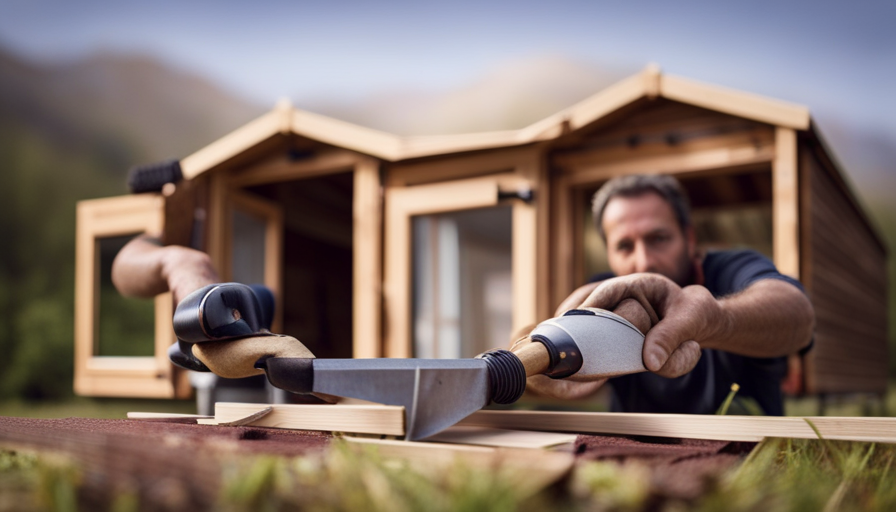Have you ever walked into a room and felt a strange unease crawling up your spine? You quickly turn around, expecting to see something eerie lurking in the shadows, only to spot tiny red spiders scurrying along the walls.
These minuscule arachnids may seem harmless, but their presence can be quite unsettling. Fear not, for I am here to guide you through the process of eliminating these unwelcome guests from your home.
In this comprehensive guide, we will explore various techniques to banish these tiny red spiders once and for all. From identifying the type of spider to introducing natural repellents and predators, we will leave no stone unturned in our quest for a spider-free sanctuary.
So, roll up your sleeves, grab your cleaning supplies, and let’s embark on this scientific journey to reclaim our homes from these pesky invaders.
Key Takeaways
- Clean and declutter your house regularly
- Seal entry points to prevent spiders from entering
- Use natural repellents like peppermint oil, vinegar solution, and citrus peel spray
- Use sticky traps to catch and eliminate spiders
Identify the Type of Spider
If you’re trying to get rid of tiny red spiders in your house, it’s important to first identify the type of spider you’re dealing with. This will help you determine the most effective methods to eliminate them.
To identify the spider species, carefully observe its physical characteristics such as body shape, leg span, and coloration. You can also use online resources or consult with a local entomologist for assistance. Additionally, look for signs of spider infestation, such as spider webs, egg sacs, or shed skin in dark corners, ceilings, or furniture crevices. Identifying the spider and understanding its behavior will enable you to choose appropriate control measures.
Once you have identified the spider species, it’s time to clean and declutter your house to discourage their presence. Spiders are attracted to cluttered and dusty areas as they provide hiding spots and prey. Start by thoroughly cleaning your house, paying special attention to areas where spiders are commonly found, such as basements, attics, and closets.
Declutter by removing unnecessary items that can accumulate dust and clutter. Regularly dust and vacuum your house to eliminate spider webs and their potential prey, such as flies or ants. By maintaining a clean and clutter-free environment, you can effectively deter spiders from infesting your house.
Clean and Declutter Your House
Declutter your dwelling to diminish the presence of those pesky crimson critters. Keeping your house clean and organized is essential in preventing the infestation of tiny red spiders. Here are some cleaning tips and organization hacks to help you get rid of them:
-
Vacuum regularly: Use a vacuum cleaner with a HEPA filter to remove any spider webs, eggs, or tiny spiders lurking in corners, crevices, and furniture.
-
Dust and wipe surfaces: Use a damp cloth to wipe down surfaces, including windowsills, baseboards, and shelves, where spiders may hide.
Remove clutter: Clear out any unnecessary items or debris that may provide hiding spots for spiders.
Organize storage areas: Store items in sealed containers to prevent spiders from making a home in them.
By following these cleaning tips and organization hacks, you can significantly reduce the spider population in your house. Next, we’ll explore natural repellents that can effectively keep these tiny red spiders at bay.
Use Natural Repellents
I’ve found that when it comes to getting rid of tiny red spiders in my house, using natural repellents can be quite effective. One natural repellent that I’ve used is peppermint oil. Not only does it have a pleasant smell, but spiders dislike the strong scent and will avoid areas where it’s applied.
Another natural repellent that has worked well for me is a vinegar solution. By mixing equal parts vinegar and water in a spray bottle and applying it to areas where spiders are present, the acidic nature of the solution repels them.
Lastly, I’ve had success with a citrus peel spray. Spiders are repelled by the strong scent of citrus, so by steeping citrus peels in water and then spraying the solution in spider-prone areas, I’ve been able to keep them away.
Peppermint Oil
To effectively address the issue of tiny red spiders in your house, consider utilizing the invigorating properties of peppermint oil. Peppermint oil has been used for centuries as a natural remedy for various pest problems due to its strong scent and repellent qualities.
Peppermint oil benefits:
- It acts as a natural deterrent, keeping spiders away from your home.
- Its refreshing aroma also helps to mask any odors that attract spiders.
- It’s safe to use around children and pets, making it an ideal choice for households with little ones.
If you don’t have peppermint oil on hand, there are alternative options available. Essential oils such as eucalyptus, lavender, or citrus can also be effective in repelling spiders.
Now, let’s move on to the next section and explore another natural solution to get rid of those tiny red spiders – the vinegar solution.
Vinegar Solution
Freshen up your space with a vinegar solution that keeps those pesky arachnids at bay. Vinegar is not only a natural spider repellent, but it also serves as an effective cleaning solution for your home. Its strong smell and acidity make it an unfavorable environment for spiders. To create the vinegar solution, simply mix equal parts of vinegar and water in a spray bottle. This solution can be used to wipe down surfaces, such as windowsills, door frames, and corners where spiders tend to hide. The acidic nature of vinegar helps to destroy any spider webs and deter spiders from returning. Additionally, vinegar is a non-toxic alternative to chemical-based repellents, making it safe for both humans and pets. Transitioning into the next section, another effective natural spider repellent is citrus peel spray.
Citrus Peel Spray
Sick of those creepy crawlers invading your space? Whip up some citrus peel spray and send those eight-legged intruders packing! Using citrus peel as a natural spider repellent is an effective DIY method for pest control. Spiders dislike the strong scent of citrus, making it a great natural deterrent.
To make your own citrus spray, simply save the peels from oranges, lemons, or grapefruits and place them in a spray bottle filled with water. Let the mixture sit for a few days to infuse. Then, spray the solution around windows, doorways, and other areas where spiders may enter your home. The powerful aroma of citrus will help keep spiders at bay.
Now, let’s move on to sealing entry points to further fortify your home against these unwanted guests.
Seal Entry Points
First, you’ll want to inspect your home for any small cracks or openings where these tiny red spiders could be getting in. Sealing these cracks is an important step in preventing the entry of these pests into your house. By doing so, you can effectively control their population and minimize the chances of encountering them. To help you understand the importance of sealing entry points, I’ve created a table below that highlights the benefits of this method.
| Sealing Cracks | Pest Control Services | |
|---|---|---|
| Saves Money | ✔️ | ❌ |
| Long-lasting Solution | ✔️ | ❌ |
| DIY Option | ✔️ | ❌ |
| Environmental Friendly | ✔️ | ❌ |
| Reduces Health Risks | ✔️ | ❌ |
Sealing cracks not only saves money but also provides a long-lasting solution. Unlike pest control services, which may require recurring visits and expenses, sealing cracks is a one-time investment. Additionally, it is a do-it-yourself option that allows you to take control of the situation. This method is also more environmentally friendly and reduces health risks associated with the use of chemicals.
By sealing entry points, you are taking a proactive step to eliminate these tiny red spiders from your house. Once you have effectively sealed any cracks or openings, you can move on to the next step of removing their food sources.
Remove Food Sources
Eliminating all tempting food sources for these pesky critters is essential if you want to ensure they never set foot in your home again. By removing their source of nourishment, you can effectively prevent infestations and keep your house spider-free. Here are some insect proofing techniques to help you accomplish this:
-
Store food in airtight containers: Spiders are attracted to open food packages, so transfer your pantry items into sealed containers to deny them access.
-
Clean up spills and crumbs immediately: Spiders are opportunistic feeders and will gladly feast on any leftover food you leave behind. Regularly sweep and vacuum your floors to eliminate these potential meals.
-
Dispose of trash properly: Spiders are drawn to the scent of rotting food, so make sure to seal your garbage tightly and take it out regularly to prevent odors from attracting them.
By following these simple steps, you can significantly reduce the chances of a spider infestation in your home.
Next, we’ll discuss the use of sticky traps to catch any remaining spiders.
Use Sticky Traps
To catch any remaining spiders, you can easily use sticky traps in your home. This will help you keep your space spider-free in a hassle-free way. Sticky traps are a simple and effective method for trapping and eliminating tiny red spiders. These traps work by luring spiders onto a sticky surface, preventing them from escaping.
You can place these traps in areas where you have noticed spider activity, such as corners, windowsills, and along baseboards. When using sticky traps, it’s important to strategically place them. Make sure to position the traps near areas where you have seen spider webs or signs of spider activity. Additionally, consider placing them in dark and hidden areas where spiders are likely to hide, such as under furniture or behind appliances.
In addition to using sticky traps, you can also incorporate natural repellents to further deter spiders from entering your home. Some effective natural repellents include essential oils like peppermint, tea tree, or lavender. These scents are known to repel spiders and can be applied to cotton balls and placed around your home.
By using sticky traps and natural repellents, you can take proactive steps to get rid of tiny red spiders in your house. In the next section, we will explore how introducing predators can help control the spider population without the use of chemicals.
Introduce Predators
One way to naturally control the spider population in your home is by introducing predators, such as certain types of spiders or insects that feed on spiders. Introducing biological control can be an effective method to keep the tiny red spiders at bay.
Here are four types of predators that you can attract to your home to combat these pesky creatures:
-
Jumping spiders: These small and agile creatures are excellent hunters and can easily catch and feed on tiny red spiders. By providing them with suitable hiding spots and a variety of insect prey, you can encourage these helpful spiders to make your home their hunting ground.
-
Ladybugs: These adorable beetles are not only aesthetically pleasing but also voracious predators. They have a particular appetite for spider mites, which are known to infest houseplants. By attracting ladybugs to your indoor plants, you can ensure that they help control the spider mite population.
-
Praying mantises: These impressive insects are known for their patience and predatory skills. Adult mantises will readily consume small spiders, making them a valuable addition to your home’s ecosystem. Ensure that your home provides them with suitable hiding places and a variety of prey to thrive.
-
Birds: Many bird species, such as swallows and sparrows, have a natural inclination for hunting insects, including spiders. By attracting these birds to your yard through the use of bird feeders and birdhouses, you can create a natural balance that helps control the spider population.
Introducing these predators into your home can be an effective way to naturally control the spider population. However, it’s important to also maintain a clean yard to prevent spiders from migrating back into your home.
Maintain a Clean Yard
To effectively get rid of tiny red spiders in your house, it’s essential to not only address the issue indoors but also take preventative measures outdoors. Proper yard maintenance plays a crucial role in creating a spider-free outdoor environment, which in turn reduces the likelihood of these pests finding their way inside.
Maintaining a clean yard is of utmost importance when it comes to spider control. Remove any debris, such as leaf piles or woodpiles, as these can provide hiding places for spiders. Regularly mow your lawn and trim vegetation to eliminate potential spider habitats. Additionally, keep your yard free from clutter and make sure outdoor storage areas are organized and tidy.
Incorporating these tips for creating a spider-free outdoor environment will not only deter spiders from entering your home but also improve the overall appearance and safety of your yard. By taking the time to properly maintain your outdoor space, you can greatly reduce the chances of tiny red spiders infesting your house.
With a well-maintained yard, you can now transition into the subsequent section about regularly inspecting and treating outdoor areas to further enhance your spider control efforts.
Regularly Inspect and Treat Outdoor Areas
Make sure you regularly check and treat your outdoor areas for spiders, as studies have shown that over 80% of spider infestations start outside the home. Regular pest control is essential in preventing these tiny red spiders from making their way into your house.
Here are some prevention measures you can take:
-
Remove any clutter: Spiders love hiding in piles of leaves, wood, or debris. Keep your yard clean and tidy to reduce potential hiding spots.
-
Trim vegetation: Trim bushes, trees, and shrubs away from your house. This will create a barrier and prevent spiders from easily accessing your home.
-
Seal cracks and crevices: Inspect your outdoor walls, windows, and doors for any openings. Seal them properly to prevent spiders from entering.
-
Use outdoor insecticides: Apply insecticides around the perimeter of your house and in outdoor areas prone to spider infestations. This helps to keep spiders away and break their life cycle.
By regularly inspecting and treating your outdoor areas, you can significantly reduce the chances of spider infestations inside your home. However, if you find that the problem persists or becomes overwhelming, it may be necessary to seek professional help.
Seek Professional Help if Needed
After diligently inspecting and treating outdoor areas for any signs of tiny red spiders, it’s important to acknowledge that sometimes, despite our best efforts, the infestation may persist.
In such cases, it’s wise to seek professional help to effectively and efficiently eradicate these tiny pests from your home. Professional pest control services possess the knowledge, expertise, and specialized equipment to address the spider infestation comprehensively. They can identify the specific species of spider and tailor their treatment methods accordingly.
These professionals can also assess the severity of the infestation and determine the best course of action, whether it involves targeted spray treatments or more advanced techniques like fogging or fumigation.
For those who prefer a more hands-on approach, there are also DIY spider repellents available on the market. These products often contain ingredients like peppermint oil, vinegar, or citrus extracts that spiders find repulsive. However, it’s important to note that while these repellents may help deter spiders temporarily, they may not eliminate the infestation entirely.
Seeking professional help is crucial when dealing with persistent tiny red spiders in your home. Their expertise in pest control and access to specialized treatments ensure a thorough and effective eradication. Alternatively, DIY spider repellents can provide temporary relief, but may not offer a permanent solution.
Frequently Asked Questions
Are all tiny red spiders harmful, or are there any that are beneficial?
There are actually beneficial tiny red spiders known as predatory mites that play a crucial role in pest control. They feed on harmful insects, such as spider mites, thrips, and aphids, reducing their populations and preventing damage to agricultural crops. These natural predators help maintain a balance in ecosystems and minimize the need for chemical pesticides.
However, it’s important to properly identify the species to differentiate between beneficial and harmful spiders, as some can still cause economic impact on agriculture.
How do you differentiate between tiny red spiders and other common household pests?
One interesting statistic is that there are over 45,000 known species of spiders worldwide. When it comes to differentiating between tiny red spiders and other common household pests, it’s important to look for identifying features.
Tiny red spiders often have a round body shape and eight legs like other spiders, but they may also have specific color patterns or markings that can help with identification. It’s crucial to consult with an expert or use reliable resources to accurately identify these pests.
Can tiny red spiders cause any health issues or allergies?
Tiny red spiders, also known as red spider mites, can indeed cause health issues and allergies. Their bites may result in itching, redness, and skin irritation. In some cases, individuals with pre-existing respiratory conditions may experience allergic reactions when exposed to their feces.
To deal with an infestation of these spiders in your home, it’s essential to maintain proper hygiene, regularly vacuum and clean affected areas, and consider using insecticides specifically designed to target mites.
Is it possible to prevent tiny red spiders from entering the house in the first place?
To prevent tiny red spiders from entering your house, there are several effective methods you can employ.
Creating a spider-proof barrier around your home is key. Seal any cracks or openings in windows, doors, and walls to deny them access.
Additionally, keeping your house clean and clutter-free will discourage their presence. Regularly vacuuming and dusting will remove any potential hiding spots.
Implementing these preventive measures will significantly reduce the likelihood of tiny red spiders invading your home.
Are there any DIY methods to control tiny red spiders that are not mentioned in the article?
Alternative control methods and natural remedies can be effective in managing tiny red spiders in the house. While the previous article mentioned common approaches like sealing cracks and using pesticides, there are other DIY methods worth considering.
These include using essential oils with strong scents like peppermint or tea tree oil, creating a vinegar solution to repel them, or using diatomaceous earth as a natural insecticide. These methods can help control tiny red spiders without the use of harsh chemicals.
Conclusion
In conclusion, getting rid of tiny red spiders in your house requires a combination of cleaning, sealing, and natural repellents. By identifying the type of spider and taking appropriate measures, such as decluttering and removing food sources, you can create an inhospitable environment for these pests.
Introducing predators and maintaining a clean yard will further discourage their presence. Regular inspections and treatments of outdoor areas are also crucial. Remember, seeking professional help is always an option if needed.
So, let’s sweep away these red spiders and restore peace to our homes!
Hi, I’m Emma. I’m the Editor in Chief of Tiny House 43, a blog all about tiny houses. While tree houses are often associated with childhood, they can be the perfect adult retreat. They offer a cozy space to relax and unwind, surrounded by nature. And since they’re typically built on stilts or raised platforms, they offer stunning views that traditional homes simply can’t match. If you’re looking for a unique and romantic getaway, a tree house tiny house might just be the perfect option.










